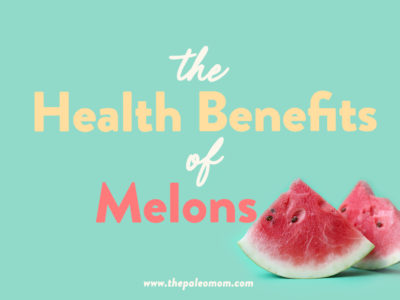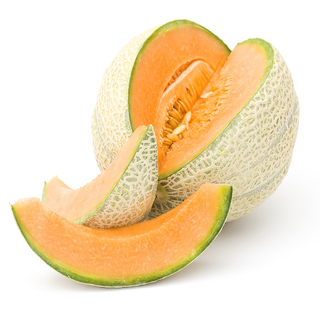 Melons are the sweet, juicy fruits produced by members of the plant family Cucurbitaceae, and are related to squash and cucumbers (botanically, they’re also technically berries!). They originated in Africa and Southwest Asia and were grown by ancient Egyptians, and were brought to Europe as early as 1350 BC (melon seeds have been found in sacred wells in some areas of Sardinia). These fruits were among the earliest domesticated plants in the Old World, and were also one of the first crops to be brought to the New World by westerners. Almost 30 million tons of melons are produced worldwide each year! (And this is a good thing! See also Why Fruit is a Good Source of Carbohydrates.)
Melons are the sweet, juicy fruits produced by members of the plant family Cucurbitaceae, and are related to squash and cucumbers (botanically, they’re also technically berries!). They originated in Africa and Southwest Asia and were grown by ancient Egyptians, and were brought to Europe as early as 1350 BC (melon seeds have been found in sacred wells in some areas of Sardinia). These fruits were among the earliest domesticated plants in the Old World, and were also one of the first crops to be brought to the New World by westerners. Almost 30 million tons of melons are produced worldwide each year! (And this is a good thing! See also Why Fruit is a Good Source of Carbohydrates.)
Table of Contents[Hide][Show]
A huge number of melon varieties exist, including:
- Watermelon, which is native to Africa and has been cultivated for over 4,000 years, with a high water content and sweet taste; it can come in many different sizes, shapes ranging from round to oblong, be seeded or seedless, and have flesh ranging from yellow to pink to red
- Cantaloupe (or rockmelon), which has mildly sweet orange flesh and is the most widely consumed melon
- Honeydew melon, which has green flesh and a sweet, rich flavor
- Canary melon, which has bright yellow skin and a sweet, mildly tangy flavor
- Persian melon, which is similar to a large cantaloupe but with a darker green rind
- Casaba melon, which is bright yellow with a very mild flavor
- Crenshaw melon, which is a hybrid of Persian and casaba melons and has an oblong shape with sweet, slightly spicy, juicy orange flesh
- Galia melon, which originated in Israel in the 1970s as a cross between a cantaloupe and honeydew melon, and is very juicy with pale green flesh
- Santa Claus melon (or Christmas melon), which originated in Spain and has a mottled green shell and very sweet, light green flesh, similar to honeydew
- Horned melon (or kiwano), a traditional fruit in Africa with spiky, bright orange skin and gooey, gelatinous, seedy flesh
- Korean melon, which is small and yellow with white lines and pale, slightly sweet flesh
- Sugar melon, which resembles a cantaloupe but is much sweeter
- Honey globe melon, which originates from Southeast Asia and has white skin with green stripes, a high sugar content, white flesh, and very juicy, soft texture
In addition to the above, a number of heirloom melons exist—some of which are grown today by various Native American tribes in New Mexico, who carry the tradition of growing melons native to the Southwest United States. Some of these include the Corrales melon, which is oblong, sweet, and juicy; the Ojo Caliente melon, which is oval with juicy pale green flesh; the Santo Domingo casaba, which has wrinkly skin and pale, sweet, juicy flesh; and the San Juan melon, which resembles a honeydew and has sweet green flesh.
Nutrients in Melons
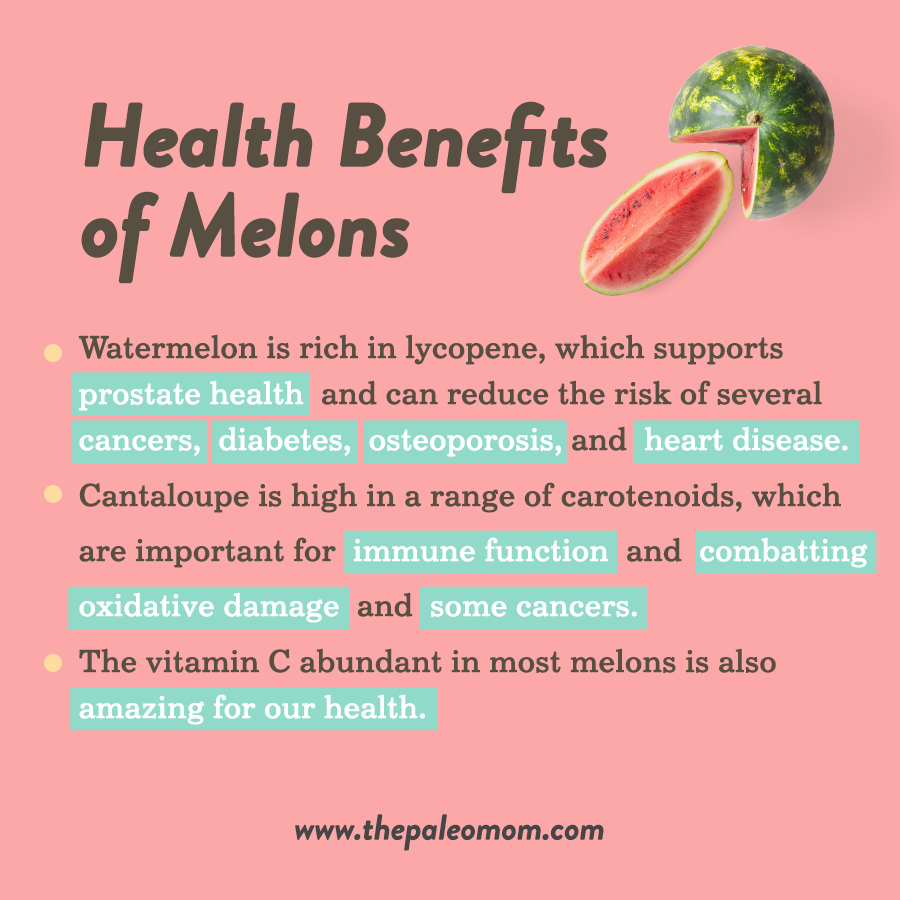 Melons vary in their nutrient profile, but tend to have very high water content, a little fiber, and notable vitamin C. Melons with orange, yellow, or red flesh also tend to be high in vitamin A (in the form of carotenoids).For example, one cup of cantaloupe—one of the most nutritious melons—contains about 100% of the DV for vitamin A and vitamin C, along with some potassium, folate, and small amounts of most other vitamins and minerals. One cup of honeydew melon or watermelon contains lower, but still noteworthy, levels of vitamin C and vitamin A. In addition, melons tend to be fairly low in calorie density due to their high water content; a cup of watermelon contains only 46 calories, and a cup of cantaloupe contains 60.
Melons vary in their nutrient profile, but tend to have very high water content, a little fiber, and notable vitamin C. Melons with orange, yellow, or red flesh also tend to be high in vitamin A (in the form of carotenoids).For example, one cup of cantaloupe—one of the most nutritious melons—contains about 100% of the DV for vitamin A and vitamin C, along with some potassium, folate, and small amounts of most other vitamins and minerals. One cup of honeydew melon or watermelon contains lower, but still noteworthy, levels of vitamin C and vitamin A. In addition, melons tend to be fairly low in calorie density due to their high water content; a cup of watermelon contains only 46 calories, and a cup of cantaloupe contains 60.
Melons also offer a range of phytochemicals that support human health (see The Amazing World of Plant Phytochemicals: Why a diet rich in veggies is so important!). Watermelon is rich in lycopene, which supports prostate health and can reduce the risk of several cancers, diabetes, osteoporosis, and heart disease. One study found that among older adult women, one-time consumption of watermelon juice (360 mL) following an overnight fast caused circulating lycopene levels to increase three-fold. Watermelon is also the richest source of a non-essential amino acid called L-citrulline, which acts as a precursor for nitric oxide synthesis and thereby provides cardiovascular support. In fact, L-citrulline supplementation and watermelon extract has been shown to reduce blood pressure in adults with pre-hypertension or hypertension, and in some studies, also appears to boost exercise performance—apparently due to bringing improvements in the L-arginine/nitric oxide pathway. Watermelon also contains the phytonutrient cucurbitacin E, which has been shown to reduce inflammation by inhibiting the activity of cyclooxygenase-2 (COX-2) and helps scavenge reactive nitrogen species.
 Cantaloupe is high in a range of carotenoids (including alpha-carotene, beta-carotene, lutein, zeaxanthin), which are important for immune function and combatting oxidative damage; some can be converted into vitamin A, which supports eye health. Beta-carotene, in particular, has demonstrated cancer-protective, cardio-protective, and immunostimulant activity, as well as showing some promise for improving skin health (in particular, increasing the skin’s ability to protect against UV radiation). Components of cantaloupe extract have been shown to protect against diabetic nephropathy (kidney disease) in rodent models of type 2 diabetes, as well as reverse diet-induced changes in blood sugar, blood lipids, insulin, and thyroid hormones. One study also found that extract from orange-fleshed honeydew melons (a cross between regular honeydew and cantaloupe) had anti-cancer activity against several cancer cell lines, and another study found that aqueous extract of cantaloupe had cytotoxic activity against human prostate cancer cells.
Cantaloupe is high in a range of carotenoids (including alpha-carotene, beta-carotene, lutein, zeaxanthin), which are important for immune function and combatting oxidative damage; some can be converted into vitamin A, which supports eye health. Beta-carotene, in particular, has demonstrated cancer-protective, cardio-protective, and immunostimulant activity, as well as showing some promise for improving skin health (in particular, increasing the skin’s ability to protect against UV radiation). Components of cantaloupe extract have been shown to protect against diabetic nephropathy (kidney disease) in rodent models of type 2 diabetes, as well as reverse diet-induced changes in blood sugar, blood lipids, insulin, and thyroid hormones. One study also found that extract from orange-fleshed honeydew melons (a cross between regular honeydew and cantaloupe) had anti-cancer activity against several cancer cell lines, and another study found that aqueous extract of cantaloupe had cytotoxic activity against human prostate cancer cells.
The vitamin C abundant in most melons is also amazing for our health. Vitamin C is necessary for the development, growth, and repair of the tissues in our body, and plays a role in collagen formation, immune function, wound healing, iron absorption, and maintaining healthy bones and teeth.
Health Benefits of Melons
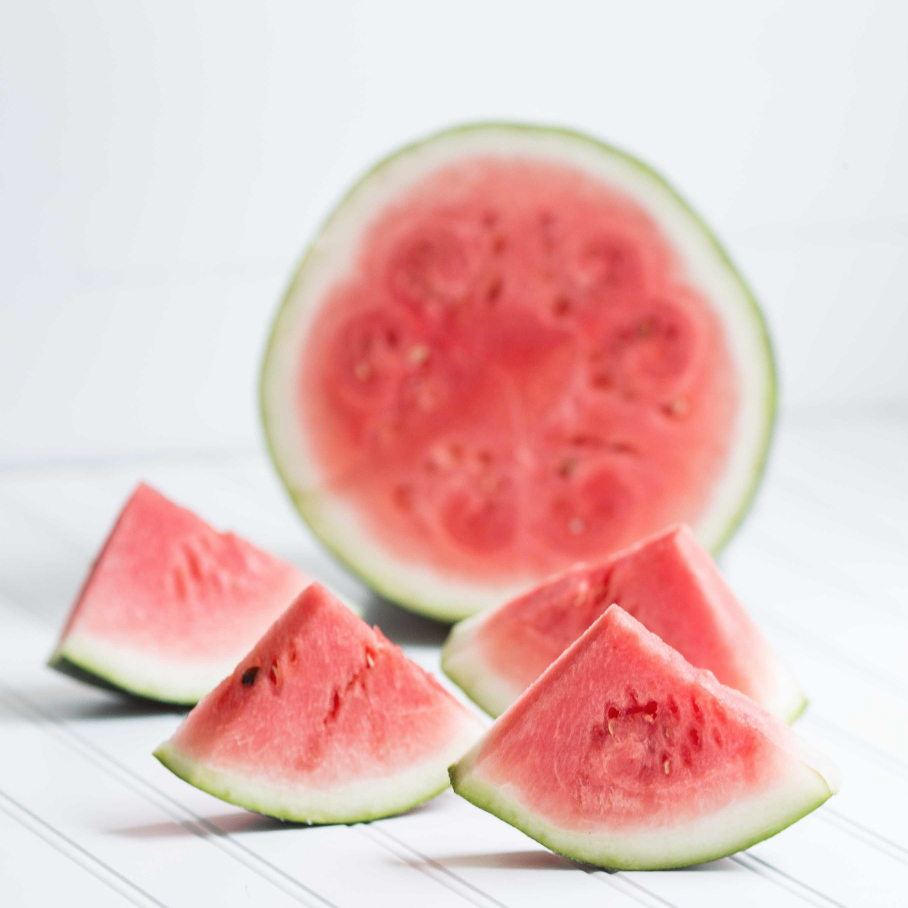 Studies of whole melon and melon juice consumption also support the idea that these fruits are a boon for our health! In one crossover trial of 33 overweight or obese adults, consuming two cups of watermelon daily for four weeks led to significantly decreased body weight, reduced BMI, lowered systolic blood pressure, and decreased the participants’ waist-to-hip ratio, while also eliciting more robust satiety responses (including reduced hunger). In addition, the watermelon consumption led to lower oxidative stress and greater total antioxidant capacity in the blood. In postmenopausal women, daily watermelon supplementation for six weeks led to decreases in arterial stiffness and aortic systolic blood pressure.
Studies of whole melon and melon juice consumption also support the idea that these fruits are a boon for our health! In one crossover trial of 33 overweight or obese adults, consuming two cups of watermelon daily for four weeks led to significantly decreased body weight, reduced BMI, lowered systolic blood pressure, and decreased the participants’ waist-to-hip ratio, while also eliciting more robust satiety responses (including reduced hunger). In addition, the watermelon consumption led to lower oxidative stress and greater total antioxidant capacity in the blood. In postmenopausal women, daily watermelon supplementation for six weeks led to decreases in arterial stiffness and aortic systolic blood pressure.
Rats supplemented with fresh watermelon juice for 14 days exhibited improved exercise performance, including significantly longer prolonged time spent swimming until exhaustion, reduced lactate and ammonia concentrations, and increased production of nitric oxide. (These results were more significant than those of a rat group supplemented with L-citrulline, suggesting watermelon components beyond L-citrulline were responsible for these effects!) In diabetic rats, watermelon juice consumption led to a reduction in fasting blood sugar levels, serum lipids, lipid peroxidation, glucose-6-phosphatase, and anti-inflammatory activities, along with a significant increase in antioxidant enzyme activities, glucose transporter levels (GLUT 2 and GLUT 4), and hexokinase activity. And, in mice, 28 days of ad libitum watermelon juice consumption appears to help modulate oxidative damage from low-dose X-ray, including significant reduction of malondialdehyde levels, significant increase of superoxide dismutase inhibition activities, and higher glutathione levels.
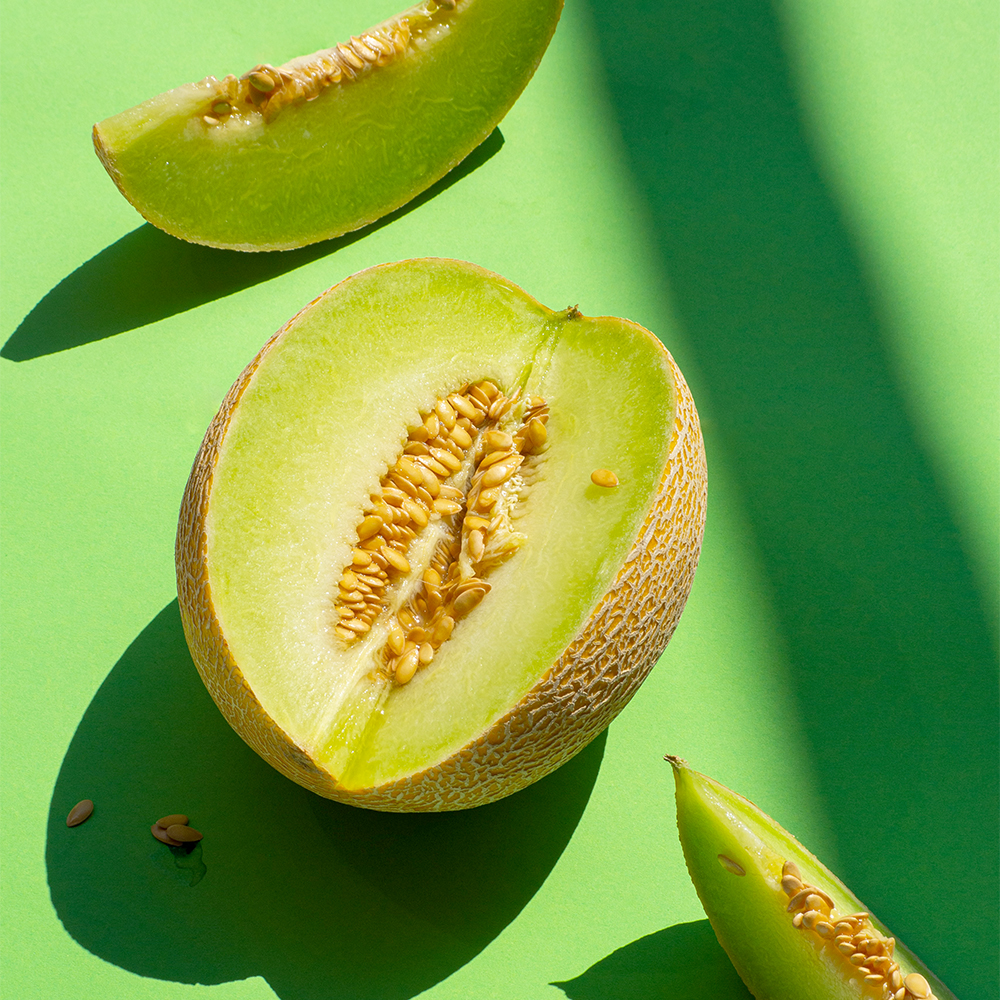 Melons Benefit the Gut Microbiome
Melons Benefit the Gut Microbiome
Melons can also support a healthy gut microbiota. In diabetic mice, watermelon juice significantly reduced fasting blood sugar, along with dramatically altering the composition of the gut microbiota: the juice increased the abundance of Ruminiclostridium_9, Parasutterella, and Clostridium_sensu_stricto_1 while levels of Oscillibacter and Ruminiclostridium decreased. Wild melon extracts have also been shown to have anti-fungal activity against Candida albicans. And, in leptin-deficient mice, supplementation with cantaloupe extract resulted in significantly lower levels of Actinobacteria, Verrucomicrobia, and Proteobacteria, along with higher levels of Bacteroidetes and Deferribacteres (all in conjunction with improvements in insulin resistance and reduced inflammation).
Melon for the Win!
The bottom line? When it comes to melons, eat up! These fruits are not only tasty and refreshing, but they supply a helpful mix of micronutrients and phytonutrients to support our health.
Nutrivore Weekly Serving Matrix
An easy-to-use and flexible weekly checklist
to help you maximize nutrient-density.
The Weekly Serving Matrix is very helpful! I’ve been eating along these lines but this really helps me know where to focus vs. which foods serve a more secondary role. It’s super helpful and has taken a lot of worry out of my meal planning. Thanks!
Jan
Here’s a handy-dandy list of melons, for your convenience!
- canary melon
- cantaloupe
- casaba
- Charentais
- Christmas melon
- Crenshaw melon
- derishi
- Galia
- honeydew
- horned melon
- melon pear
- muskmelon
- net melon
- ogen melon
- Persian melon
- Russian melon (aka Uzbek melon)
- sharlyn
- sweet melon
- watermelon
- winter melon
Citations
Ajiboye BO, et al. “Antidiabetic activity of watermelon ( Citrullus lanatus) juice in alloxan-induced diabetic rats.” J Diabetes Metab Disord. 2020 Apr 28;19(1):343-352. doi: 10.1007/s40200-020-00515-2. eCollection 2020 Jun.
Egea MB, et al. “Intake of Watermelon and Watermelon Byproducts in Male Mice Fed a Western-Style Obesogenic Diet Alters Hepatic Gene Expression Patterns, as Determined by RNA Sequencing.” Curr Dev Nutr. 2020 Jul 15;4(8):nzaa122. doi: 10.1093/cdn/nzaa122. eCollection 2020 Aug.
Ellis AC, et al. “Watermelon Juice: a Novel Functional Food to Increase Circulating Lycopene in Older Adult Women.” Plant Foods Hum Nutr. 2019 Jun;74(2):200-203. doi: 10.1007/s11130-019-00719-9.
Figueroa A, et al. “Effects of watermelon supplementation on arterial stiffness and wave reflection amplitude in postmenopausal women.” Menopause. 2013 May;20(5):573-7. doi: 10.1097/GME.0b013e3182733794.
Figueroa A, et al. “Influence of L-citrulline and watermelon supplementation on vascular function and exercise performance.” Curr Opin Clin Nutr Metab Care. 2017 Jan;20(1):92-98. doi: 10.1097/MCO.0000000000000340.
Gholampour-Azizi I, et al. “In vitro Antifungal Activity of Cucumis melo on Candida albicans.” Zahedan J Res Med Sci. 2015; 17(7). doi: 10.17795/zjrms1019.
Lee D, et al. “Therapeutic Effect of Cucumis melo L. Extract on Insulin Resistance and the Gut Microbiome in Lep ob/Lep ob Mice.” Evid Based Complement Alternat Med. 2018 Feb 5;2018:8159261. doi: 10.1155/2018/8159261. eCollection 2018.
Lester G. “Melon (Cucumis melo L.) fruit nutritional quality and health functionality.” HortTechnology. 1997 Jul;7(3):222-227.
Lum T, et al. “Effects of Fresh Watermelon Consumption on the Acute Satiety Response and Cardiometabolic Risk Factors in Overweight and Obese Adults.” Nutrients. 2019 Mar 12;11(3):595. doi: 10.3390/nu11030595.
Mohammad MKA, et al. “Watermelon (Citrullus lanatus (Thunb.) Matsum. and Nakai) juice modulates oxidative damage induced by low dose X-ray in mice.” Biomed Res Int. 2014;2014:512834. doi: 10.1155/2014/512834. Epub 2014 Apr 29.
Naito Y, et al. “Reduction of diabetes-induced renal oxidative stress by a cantaloupe melon extract/gliadin biopolymers, oxykine, in mice.” Biofactors. 2005;23(2):85-95. doi: 10.1002/biof.5520230204.
Parmar HS & Kar A. “Possible amelioration of atherogenic diet induced dyslipidemia, hypothyroidism and hyperglycemia by the peel extracts of Mangifera indica, Cucumis melo and Citrullus vulgaris fruits in rats.” Biofactors. 2008;33(1):13-24. doi: 10.1002/biof.5520330102.
Ridwan R, et al. “Supplementation of 100% Flesh Watermelon [ Citrullus lanatus (Thunb.) Matsum. and Nakai] Juice Improves Swimming Performance in Rats.” Prev Nutr Food Sci. 2019 Mar;24(1):41-48. doi: 10.3746/pnf.2019.24.1.41. Epub 2019 Mar 31.
Wong SY, et al. “Drinking Watermelon Juice Shift the Gut Microbiome in Diabetic Mice (P20-025-19).” Curr Dev Nutr. 2019 Jun; 3(Suppl 1): nzz040.P20-025-19. doi: 10.1093/cdn/nzz040.P20-025-19
Zhang X, et al. “Anticancer Properties of Different Solvent Extracts of Cucumis melo L. Seeds and Whole Fruit and Their Metabolite Profiling Using HPLC and GC-MS.” Biomed Res Int. 2020 Feb 24;2020:5282949. doi: 10.1155/2020/5282949. eCollection 2020

